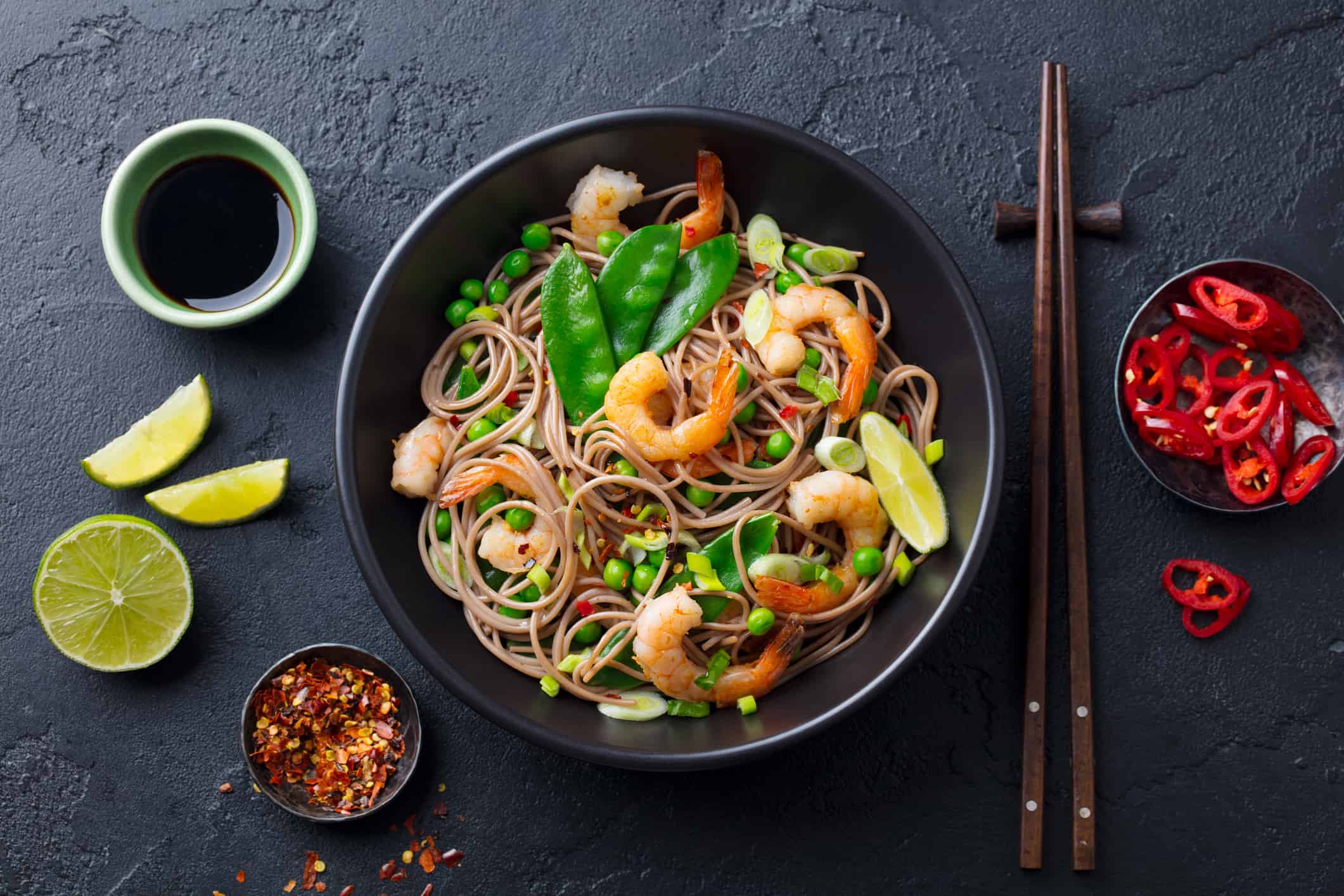When considering your options between Lo Mein vs. Chow Mein noodles, both these Chinese noodle dishes are delicious, flavorful choices. But, aside from the name, how are they different? Both dishes combine protein, veggies, and delicious noodles. However, the preparation process and the type of noodles used in each are different. The end result of Lo Mein and Chow Mein should not be confused.
Their names actually indicate their differences. “Lo Mein” comes from the Cantonese expression “lou min.” This translates to the stirring process of noodles (via 196 Flavors). Whereas “Chow Mein,” according to Collins Dictionary translates to “chǎo,” meaning fry, and “miàn,” meaning noodle.
Let’s take a closer look at some of those differences. Keep on reading and we’ll talk about the histories of these Chinese noodle dishes. We'll also look at some variations in modern recipes. By the end of this post, you get to know the differences between Lo Mein vs. Chow Mein. Whether you’re ordering at a restaurant, or taking a stab at making it yourself, you’ll be prepared with all the most important details. Happy reading!
Lo Mein vs. Chow Mein Noodles: How Are They Different?
For Lo Mein vs. Chow Mein Noodles, major differences include the cooking process, noodle type, and some variations in ingredients. Lo Mein is typically cooked with fat, chewy egg noodles, while Chow Mein uses thinner egg noodles. Lo Mein is better with the use of freshly made noodles. Meanwhile, Chow Mein dishes can be made from dried noodle varieties. Let's take a closer look at those final dishes.
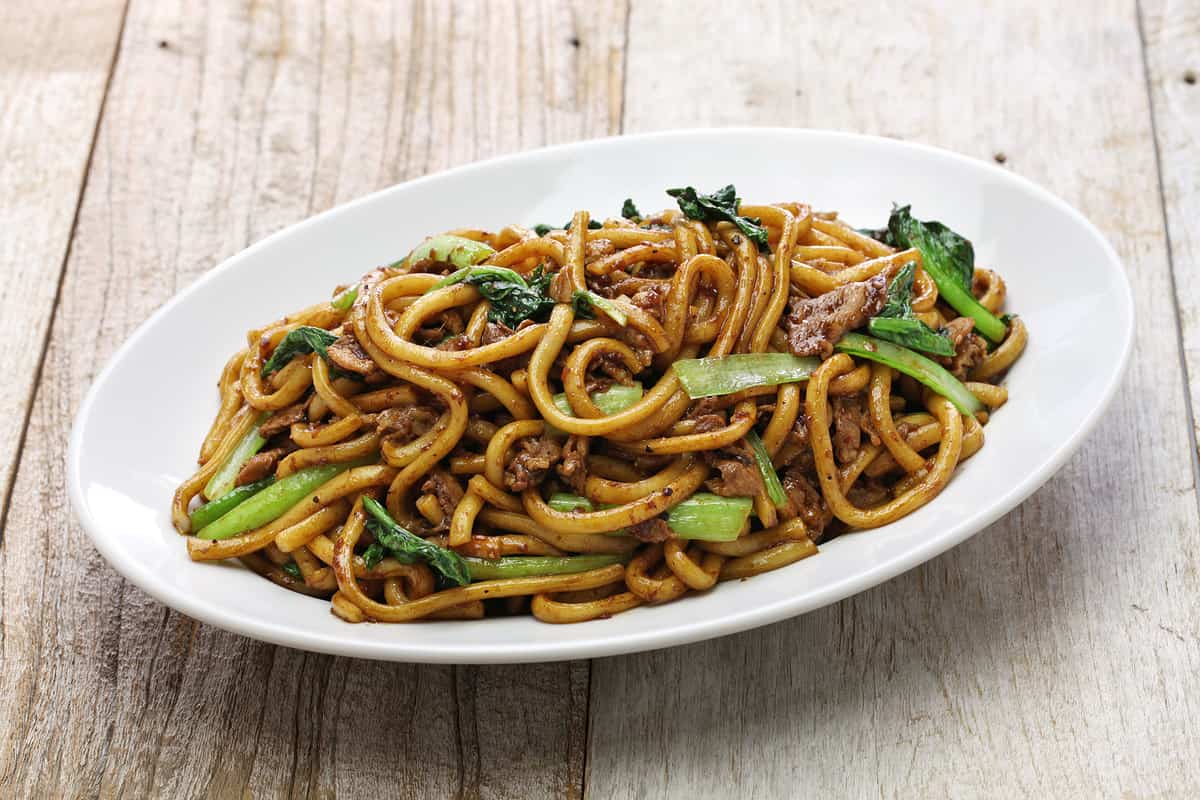
©iStock.com/bonchan
What Are Lo Mein Noodles?
Lo Mein, which translates to “stirred,” or “tossed” noodles, is a Chinese noodle dish that's made from egg noodles. Egg noodles consist of wheat flour and egg that are combined to form a dough. They are then properly shaped for the long and chewy noodles used in Lo Mein dishes. The noodles are cooked and then tossed in a sauce with a protein of some kind, as well as stir-fried veggies (via Taste Atlas).
History And Origin
Lo Mein is a dish that was likely invented in Northern China. The North had more access to wheat and many different kinds of protein than areas of the South. Wheat and egg-based noodles are prevalent in China, although there are variations of Lo Mein dishes in other Asian Countries (via Woodland Foods).
How to Cook Lo Mein
If you can, find fresh Lo Mein noodles. Try your local Asian grocery, or try making them yourself! In a pinch, packaged Lo Mein noodles will do. Put the noodles into a pot of boiling water and cook until just soft enough for eating. You don't want overcooked noodles as the base of your Lo Mein dish! Next, you'll make the sauce which is comprised of ingredients soy and teriyaki sauce, ginger, and honey. You can add more ingredients like oyster sauce, sesame oil, and chicken stock (via The Food Network).
Next, time to chop your veggies, which you can also pick and choose when making Lo Mein at home. Carrots, celery, bok choy, scallions, onions, and peppers are all popular choices. These will be stir-fried in vegetable oil before it's time to add the sauce mixture and your noodles to the mix (via Allrecipes).
If you're adding protein to your Lo Mein, cook it separately first. Then add it with the noodles and sauce so it gets tossed along with the rest of the dish before serving.
Nutritional Value
WebMD does not positively rank Lo Mein as having much nutritional value. The high sodium content from the sauce as well as the carbohydrates from the noodles, make it a heavy dish for digestion. Live Strong breaks down 1 cup of beef Lo Mein as follows. There are around 108 calories, 5. grams of protein, 1.6 grams of fat, 17.5 grams of carbohydrates, 3.2 grams of sugar, and 1 gram of dietary fiber. It has 455 milligrams of sodium and 6.6 milligrams of cholesterol. Depending on the kind of meat it can provide iron and other nutrients to your diet. The best way to make Lo Mein healthier is to simply cook it yourself!
Popular Variations
As mentioned above, there are other variations throughout Asia of Lo Mein Noodles. Lo Mein can be served with egg-free wheat noodles are called ban mian. And in Indonesia, the Lo Mein noodles are thick and served with a heavy meat sauce as well as seafood (via 196 Flavors).
What is Chow Mein?
Chow Mein is a wheat and egg-based noodle that is parboiled in water and then crisped in a pan. Chow Mein translates to “fried” noodles, which refers to the cooking process. The Chow Mein sauce is slightly milder than Lo Mein but has similar ingredients. You can add veggies and protein to the skillet and the end result are crispy, flavorful noodles.
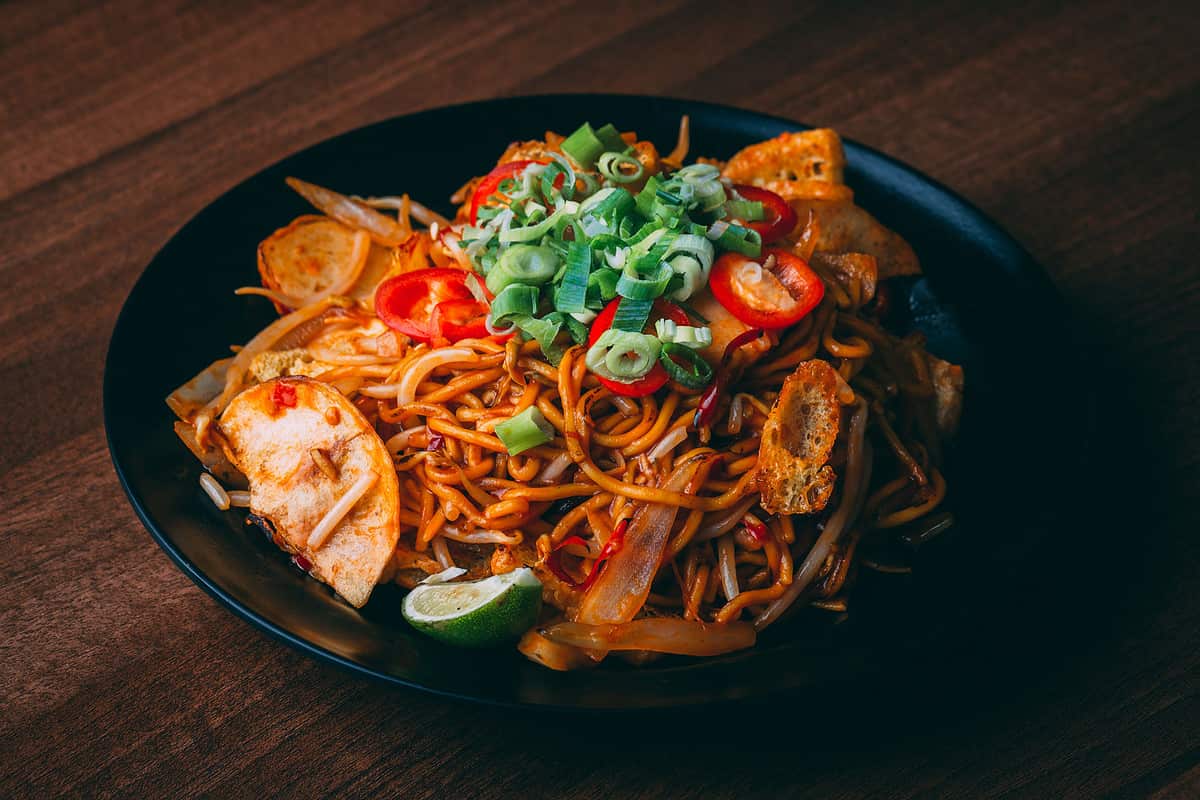
©iStock.com/Wirestock
History and Origin
Like Lo Mein, Chow Mein originated in China. It has since been packaged and reproduced in many forms, including canned versions (via Mashed)! Chow Mein has a meandering history with ties to ancient China before eventually making its way to the States, where it became popular in school cafeteria lunches and as a sandwich in Massachusetts! That's right, according to NPR, the factory workers of Fall River, Massachusetts. In the 1800s, lots of Chinese immigrants came to work in textile factories and restaurants adapted a dish to be more familiar so that it would sell! Thus, combining hamburger bread for the European workers and Chow Mein for the Chinese workers, the Chow Mein Sandwich was born. Modern Chow Mein dishes are featured in Chinese restaurants with varying ingredients.
How to Cook Chow Mein
Chow Mein is parboiled, which means it is partially cooked in boiling water, and then transferred to a pan to fry up with the rest of the ingredients. This dish is much more texture heavy than Lo Mein. You can get Chow Mein noodles at the store and boil them until they're just done, try not to overcook them! Next, chop up veggies of your choice and toss them into a pan with some oil. Protein should be cooked separately first before being added, along with the noodles and the sauce to fry all together. The Chow Mein sauce is comprised of soy sauce, sesame oil, and oyster sauce, which is similar to Lo Mein's sauce. But you also add in granulated sugar, cornstarch, and maybe some chicken broth. The end result is sweet and savory, but milder than the Lo Mein sauce (via The Food Network).
Nutritional Value
Live Strong breaks down the nutritional value of 1 cup of beef Chow Mein as follows. It has about 286 calories, 9.2 grams of total fat, 27 grams of carbohydrates, 2.6 grams of dietary fiber, 5 grams of sugar, and 23 grams of protein. Cholesterol for this dish clocks in at 48.4 milligrams, with sodium at 803 milligrams. Depending on the added protein and vegetables, Chow Mein can contain vitamins and minerals such as vitamins B, C, E, and K, as well as niacin, zinc, riboflavin, folate, iron, copper, and potassium, just to name a few. Again, the best way to cut out bad concentrations in this dish is simple to make it yourself.
Possible Alternatives To Lo Mein And Chow Mein Noodles
Because both dishes used wheat-based, egg noodles, you can substitute these noodles for wheat-based pasta in a pinch. There are many different kinds of pasta, some of which are gluten-free. You can substitute the heavier ingredients of these sauces for their low-fat or low-sodium counterparts and pick your choice of veggies and proteins to style these dishes to your personal preferences.
Are Lo Mein and Chow Mein Noodles the Same Thing?
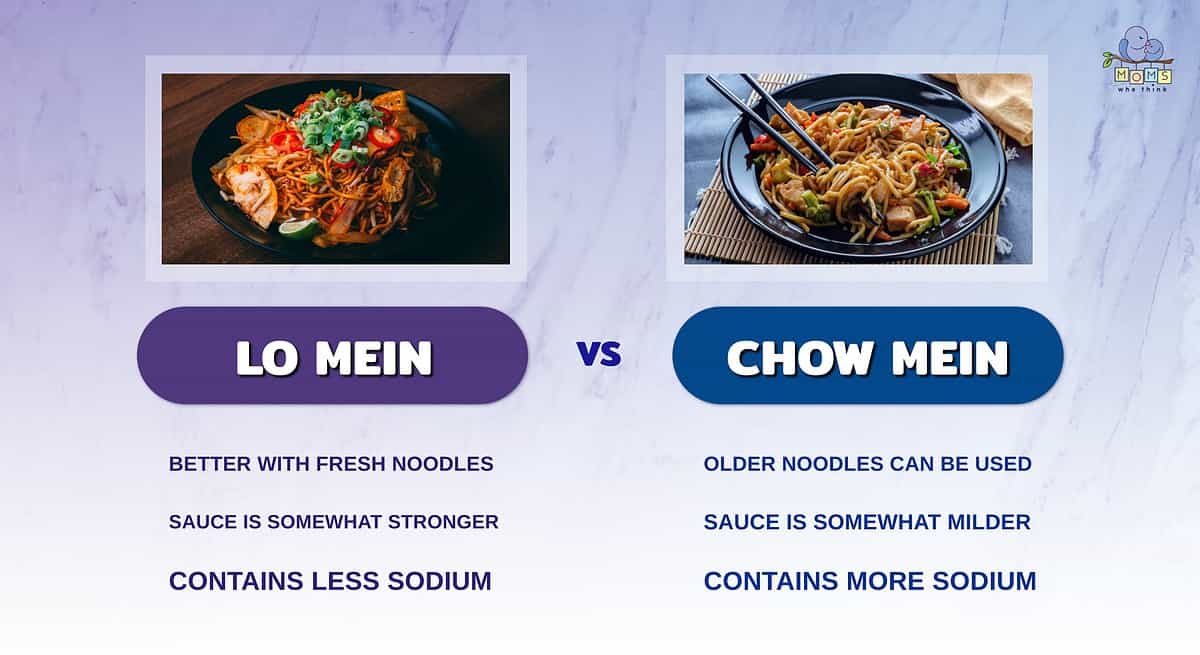
- Lo mein should be cooked with fresh noodles, when possible. The use of fresh noodles is less important in chow mein.
- The sauces for these two noodle dishes are fairly similar, but you'll find that lo mein's is somewhat stronger.
- An important distinction is that lo mein contains less sodium than chow mein. Both of these dishes are high in sodium, but you can reduce their sodium content by making them at home.
In conclusion, looking at Lo Mein vs. Chow Mein noodles, it is clear they are not the same thing. The noodles are a different size, the sauces have a different taste and the resulting textures from cooking is quite different overall. While they have a common history, these dishes are different, and now you'll know which one to order or how to cook your own at home!
Print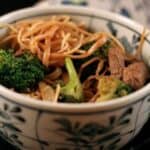
Beef Broccoli Lo Mein
- Yield: 6 servings 1x
Ingredients
- 8 ounces uncooked spaghetti
- 1 teaspoon dark sesame oil
- 1 tablespoon peanut oil
- 1 tablespoon minced peeled fresh ginger
- 4 cloves garlic, minced
- 3 cups chopped broccoli
- 1 1/2 cups vertically sliced onion
- 1 (1 pound) flank steak, trimmed and cut across grain into long thin strips
- 3 tablespoons low-sodium soy sauce
- 2 tablespoons brown sugar
- 1 tablespoon oyster sauce
- 1 tablespoon chile paste with garlic
Instructions
- Cook pasta according to package directions, omitting salt and fat; drain. Combine pasta and sesame seed oil, tossing well to coat.
- While pasta cooks, heat peanut oil in a large nonstick skillet over medium-high heat. Add ginger and garlic, sauté 30 seconds. Add broccoli and onion; sauté 3 minutes. Add steak; sauté 5 minutes or until done. Add pasta mixture, soy sauce, and remaining ingredients; cook 1 minutes or until lo mein is thoroughly heated, stirring constantly.
Nutrition
- Serving Size: 1⅓ cups
- Calories: 237
- Sodium: 382mg
- Fat: 9.3g
- Saturated Fat: 3g
- Carbohydrates: 39.1g
- Fiber: 2.9g
- Protein: 21.7g
- Cholesterol: 36mg
The image featured at the top of this post is ©iStock.com/AnnaPustynnikova.
